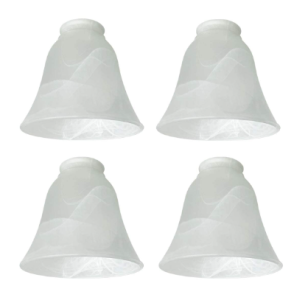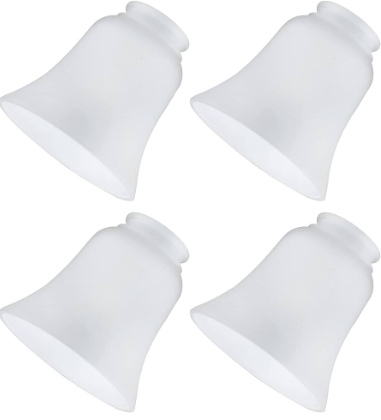Ceiling Light Cover Replacement
In the realm of interior design and home improvement, every detail matters. From the grandest furniture pieces to the tiniest accessories, each element plays a vital role in creating an atmosphere that reflects the homeowner’s style and preferences. Among these often-overlooked elements, the ceiling light cover stands out as an unassuming yet impactful component. It not only diffuses light but also adds a touch of elegance and character to any room. When it comes to upgrading the aesthetics and functionality of your living space, exploring the best ceiling light cover replacements can make a substantial difference.
The Importance of Ceiling Light Covers: Beyond Illumination
Ceiling light covers, also known as light shades or diffusers, serve a dual purpose. They soften and distribute the light emitted from the fixture, preventing harsh glare and creating a more ambient and welcoming environment. Additionally, these covers act as decorative accents, contributing to the overall design and theme of a room. Whether your home exudes a contemporary, traditional, industrial, or minimalist vibe, the right ceiling light cover replacement can tie the entire aesthetic together seamlessly.
Factors to Consider When Choosing a Ceiling Light Cover Replacement
Style and Design: The first consideration is the style and design that matches your interior theme. Options range from frosted glass covers that provide a soft, diffused light to intricately designed metal covers that add a touch of sophistication. Choose a cover that complements your existing decor while elevating its visual appeal.

Material: Ceiling light covers come in various materials, each offering a unique look and feel. Glass covers provide a classic and timeless appearance, while acrylic and plastic covers can be more modern and lightweight. Consider the durability, ease of cleaning, and maintenance requirements of each material.
Size and Compatibility: Ensure that the replacement cover is the appropriate size for your light fixture. Measure the diameter of the existing cover or fixture to avoid any mismatches. Some covers come with adjustable fittings to accommodate different sizes.
Light Diffusion: The primary purpose of a ceiling light cover is to diffuse the light evenly across the room. Look for covers that offer effective light diffusion without creating harsh shadows or uneven illumination.
Energy Efficiency: If energy efficiency is a concern, consider covers that allow maximum light transmission while minimizing energy consumption. Frosted or opal covers can help achieve a balance between brightness and energy efficiency.
Installation: Opt for a replacement cover that is easy to install or compatible with your existing fixture. Some covers require simple clip-on or screw-on mechanisms, while others might involve a more complex installation process.
Cleaning and Maintenance: Choose a cover that can be easily cleaned and maintained without much hassle. Dust and grime accumulation can impact the quality of light and the overall appearance of the cover.
Exploring the Best Ceiling Light Cover Replacements
Frosted Glass Covers: These timeless covers provide a soft and diffused light, making them ideal for spaces where a gentle ambiance is desired. They come in various shapes and sizes, offering versatility in design. Frosted glass covers are popular for their ability to create a warm and inviting atmosphere.

Crystal and Chandelier Covers: For a touch of opulence and luxury, crystal and chandelier-style covers are unbeatable. They refract light beautifully, creating dazzling patterns that transform any room into a sophisticated haven.
Industrial Cage Covers: If your decor leans towards the industrial or rustic side, consider metal cage covers. These covers often feature geometric designs and exposed bulbs, adding a touch of raw charm to your space.
Artistic and Patterned Covers: Inject personality into your room with artistic or patterned covers. These covers can be made from a variety of materials, including glass and fabric, and showcase intricate designs that become focal points in the room.
Modern Acrylic Covers: Acrylic covers offer a contemporary look while being lightweight and durable. They are available in various shapes and designs, making them suitable for modern and minimalist interiors.
Customizable DIY Covers: Unleash your creativity by opting for customizable DIY covers. You can paint, decorate, or personalize these covers to align perfectly with your decor theme.
A Guide to Choosing the Best Ceiling Light Cover Replacement
Ceiling light covers play a crucial role in enhancing the aesthetics of your space while diffusing and directing light. Whether you’re looking to replace a broken cover or update the style of your ceiling fixture, selecting the right replacement cover is essential. This guide provides you with a step-by-step process to help you choose the best ceiling light cover replacement.
Measurements and Compatibility:
Before you start searching for a replacement cover, accurately measure the dimensions of your existing cover. Note down the diameter or length and width, as well as the type of fitting (flush mount, semi-flush, pendant, etc.). This will ensure that the replacement cover fits perfectly onto your existing fixture.
Material and Design:
Consider the overall design theme of your room. Ceiling light covers come in various materials like glass, acrylic, plastic, and fabric. Choose a material that complements your interior décor. Additionally, pick a design that matches or enhances the style of your space – modern, vintage, minimalist, or ornate.
Light Diffusion and Transparency:
Evaluate the level of light diffusion you desire. Some covers are opaque, creating softer and more diffused lighting, while others are transparent, providing more direct light. Consider the function of the room and the desired ambiance when selecting the level of transparency.
Maintenance and Cleaning:
Different materials require varying levels of maintenance. Glass covers might need occasional cleaning to prevent dust and smudges, while plastic or acrylic covers are easier to wipe clean. Choose a cover that aligns with your willingness and ability to maintain its appearance.
Energy Efficiency:
If you’re concerned about energy efficiency, consider covers that maximize light output while minimizing glare. Frosted or textured covers are excellent choices for dispersing light evenly and reducing harsh glare.
Budget:
Set a budget before you start shopping. Ceiling light covers come in a wide price range, depending on materials and designs. Determine how much you’re willing to spend and explore options within that range.
Replacement Process:
Some ceiling light covers are easier to replace than others. Review the installation process before making a purchase. Ensure you’re comfortable with the steps involved or be ready to hire a professional if needed.
Safety and Electrical Compatibility:
If you’re replacing the entire fixture along with the cover, ensure that the new fixture is compatible with your existing wiring and electrical setup. Safety should always be a top priority.
Read Reviews and Seek Recommendations:
Reading reviews from other customers can provide valuable insights into the quality, durability, and overall satisfaction with a specific ceiling light cover replacement. You can also seek recommendations from friends, family, or online forums.
Warranty and Return Policy:
Check if the replacement cover comes with a warranty. This can give you peace of mind knowing that you’re investing in a quality product. Also, familiarize yourself with the seller’s return policy in case the cover doesn’t meet your expectations.
Conclusion
In the world of interior design, it’s often the subtle details that contribute to the overall beauty and functionality of a space. Ceiling light cover replacements offer a unique opportunity to enhance your home’s ambiance and aesthetics while maintaining efficient illumination. Whether you’re seeking to infuse elegance, modernity, or individuality into your living spaces, the right ceiling light cover can undoubtedly make a remarkable difference. By considering factors like style, material, size, and light diffusion, you can select the best ceiling light cover replacement that not only suits your practical needs but also elevates the allure of your home.
FAQs about “Best Ceiling Light Cover Replacement”
What is a ceiling light cover replacement and why might I need one?
A ceiling light cover replacement refers to swapping out the protective or decorative cover that encases the light bulb in a ceiling fixture. You might need to replace it due to damage, discoloration, or when updating the aesthetics of your space.
How do I choose the right ceiling light cover replacement for my fixture?
To choose the right replacement cover, consider the size and shape of your existing fixture, the type of lighting effect you desire (diffused or direct), and the overall style of your room. Take measurements and consult the manufacturer’s recommendations to ensure a proper fit.
What are the different types of ceiling light covers available?
Ceiling light covers come in various styles, such as flush-mount covers, semi-flush covers, pendant-style covers, and more. They can be made from materials like glass, acrylic, fabric, or metal. Some covers are clear, frosted, or patterned to influence the light’s diffusion and appearance.
Can I replace a ceiling light cover on my own, or should I hire a professional?
Many ceiling light covers are designed to be user-replaceable and come with easy-to-follow instructions. If you’re comfortable with basic DIY tasks and have the necessary tools, you might be able to replace it yourself. However, if the fixture is complex or you’re unsure, it’s recommended to consult a professional electrician to ensure safety.
Are there energy-efficient options for ceiling light cover replacements?
Yes, energy-efficient options are available. Some covers are designed to enhance the distribution of light while minimizing energy consumption. Consider covers that are compatible with LED or other energy-efficient light bulbs. Additionally, choosing a cover that diffuses light effectively can help reduce the need for higher wattage bulbs while maintaining adequate brightness
